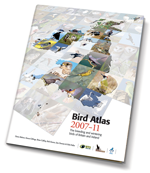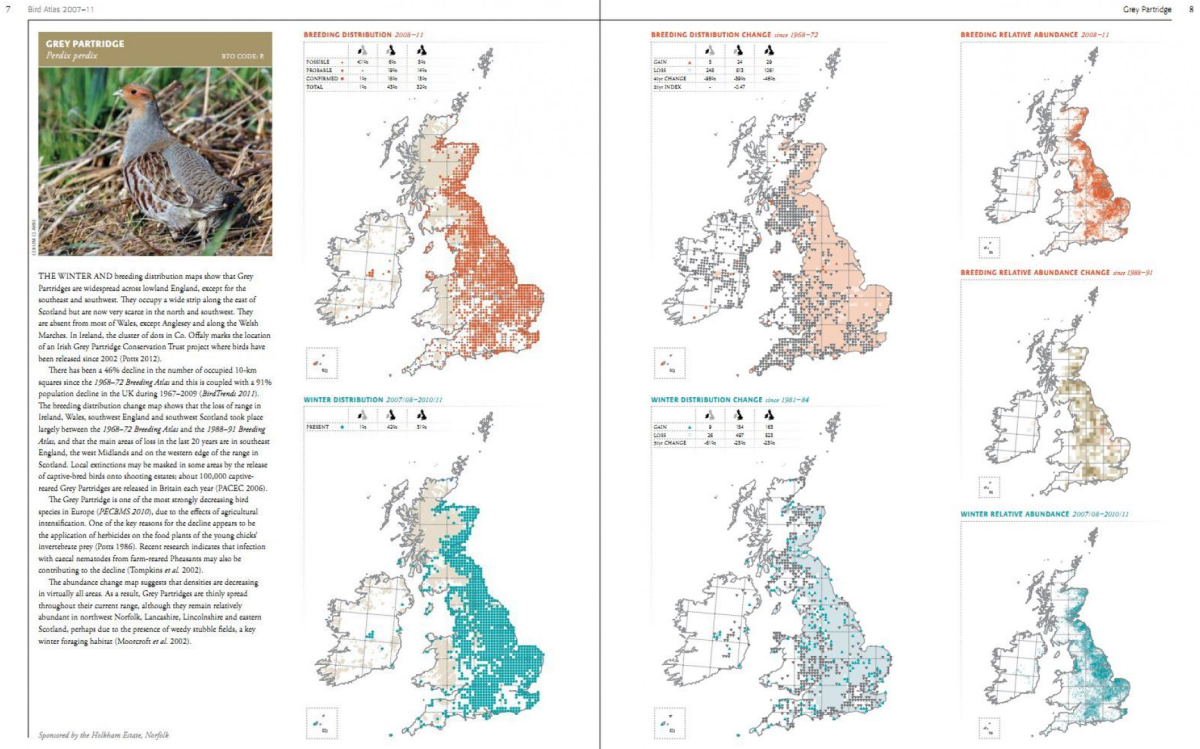
Bird Atlas 2007-11: The Breeding and Wintering Birds of Britain and Ireland
Dawn Balmer, Simon Gillings, Brian Caffrey, Bob Swann, Iain Downie & Rob Fuller
There are really only two books you need to be a British or Irish birder. One is the Collins Bird Guide. The other has finally been published: Bird Atlas 2007-11 is here at last.
First of all, I do have to admit an interest here, with the authors being colleagues and friends. However, it’s difficult to imagine that anyone could be anything other than hugely impressed with this mighty tome. And it is mighty, weighing in at 3.6 kg. It’s certainly not a book to take into the field with you. Moreover, it’s not just a big dry book of maps, but it’s pretty stunning to flick through also, with specially commissioned artwork and hundreds of hand-picked photos.
The statistics behind the book are mind-blowing. Following several years of planning and fund-raising by the British Trust for Ornithology, Scottish Ornithologists Club and BirdWatch Ireland, fieldwork started in November 2007 and continued until July 2011. Over this time, about 40,000 observers submitted about 19 million records to the project. Every corner of Britain and Ireland was visited. The distance walked during the timed tetrad visits is equivalent to walking around the equator 20 times. Personally, I remember plodding around various bits of unremarkable farmland in the middle of Norfolk, but also taking the opportunity to knock off a few squares up in the North York Moors, a very pleasant departure. In fact, such a high proportion of the people reading this review will have been involved in one way or another, it occurs to me that it’s a bit of a waste of time telling you about it!
Most of the book is obviously made up of the species accounts. These combine (where relevant) the winter and breeding information in the same account, allowing for fascinating direct comparison. The maps are obviously the main feature of the book (it’s an atlas, see?) with up to seven maps per species showing distribution, relative abundance and change since previous atlases, for winter and the breeding season. One really simple feature that I particularly like is the addition of shading for higher ground (over 200 m), which I find really brings the distributions of so many birds into sharp focus. Each account has a relatively short piece of text which aims to draw out the key features revealed by the maps, and helpfully directs the reader to further sources as required.
 In addition, there are some fascinating introductory chapters. Some of these describe the “how we did it”, which will be of wide interest but perhaps particularly valuable reading for anyone planning an atlas project in the future. The chapter covering the development of the online systems stands out as particularly novel, and will be a really valuable historical reference in years to come as this fast-moving area changes beyond recognition. There is detailed coverage of the statistical methods used to generate the authoritative statistics on range change and relative distribution. Perhaps of most interest to the general reader though will be Chapter 6 which makes a first attempt (and there will doubtless be many others) to distil the messages revealed by the Atlas. The really striking thing about this book, and many other repeat atlases, is how much change there is in the environment over a relatively short time period. Some of this change is obvious to all birders out there, with increases in Little Egrets and Red Kites probably the most obvious, and the rapid disappearance of Turtle Doves the most depressing. But what on earth is happening to Green Woodpeckers in west Wales? And why, after all these years, have Great Spotted Woodpeckers decided it’s time to invade Ireland?
In addition, there are some fascinating introductory chapters. Some of these describe the “how we did it”, which will be of wide interest but perhaps particularly valuable reading for anyone planning an atlas project in the future. The chapter covering the development of the online systems stands out as particularly novel, and will be a really valuable historical reference in years to come as this fast-moving area changes beyond recognition. There is detailed coverage of the statistical methods used to generate the authoritative statistics on range change and relative distribution. Perhaps of most interest to the general reader though will be Chapter 6 which makes a first attempt (and there will doubtless be many others) to distil the messages revealed by the Atlas. The really striking thing about this book, and many other repeat atlases, is how much change there is in the environment over a relatively short time period. Some of this change is obvious to all birders out there, with increases in Little Egrets and Red Kites probably the most obvious, and the rapid disappearance of Turtle Doves the most depressing. But what on earth is happening to Green Woodpeckers in west Wales? And why, after all these years, have Great Spotted Woodpeckers decided it’s time to invade Ireland?
When I was a young keen schoolboy birder in the 80s, with no internet, no smartphone, in fact no knowledge at all of the rest of the ornithological world, I came across the 1968-72 Breeding Bird Atlas in our local library in north Leeds. It was the first time I’d heard of the BTO and the concept of bird monitoring. The maps in that book were enormously inspiring: I remember copying out (by hand) a list of all the species and the numbers of squares they were found in. I’ve spoken to many other people recently who seem to have had very similar experiences from the previous atlases, and I really hope this one is similarly inspiring to a new generation of birders. Bird Atlas 2007-11 is the product of an incredible amount of hard work, both by the volunteers and the authors. All you need to do is buy a copy. Or two. And go and ask your local library if they’ve got it...
